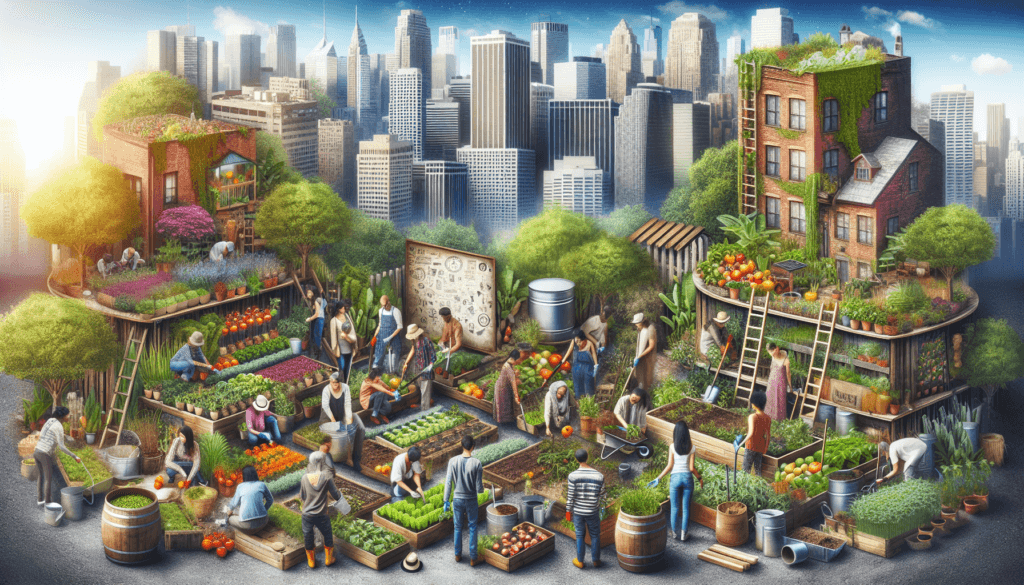Urban gardening has emerged as a vibrant trend in recent years, captivating the attention and imagination of individuals across the globe. As our cities continue to expand and nature becomes elusive, urban gardening provides a unique opportunity for people to reconnect with the earth and cultivate their own green havens amidst the concrete jungle. In this article, we will take a closer look at the cultural significance of urban gardening, examining how it not only beautifies our surroundings but also fosters community, promotes sustainability, and enhances well-being. Embark on this journey of exploration and discover the transformative power of urban gardening in enriching our lives and reconnecting us with nature in unexpected ways.

History of Urban Gardening
Origins of urban gardening
Urban gardening has a rich and diverse history that dates back to ancient civilizations. From the Hanging Gardens of Babylon to the terrace farms of the Inca Empire, people have long been cultivating plants in urban environments. In more recent centuries, urban gardening became a necessity for many as industrialization led to the rapid expansion of cities and a disconnect from rural agricultural practices.
Urban gardening as a response to industrialization
The rise of industrialization in the 19th and 20th centuries brought about profound changes in society. As people flocked to cities in search of employment, urban areas became crowded and polluted. In response to these challenging living conditions, urban gardening emerged as a way for individuals to reconnect with nature and provide for their families. Window boxes, rooftop gardens, and community plots became common sights in many urban centers.
Impact of World War II on urban gardening
World War II had a profound impact on urban gardening. With resources scarce and food rationing in place, individuals were encouraged to grow their own food to supplement their diets. Victory gardens, as they came to be known, were an essential part of the war effort. These gardens not only provided much-needed sustenance but also boosted morale and instilled a sense of community spirit among the populace.
Benefits of Urban Gardening
Promoting sustainable living
Urban gardening plays a vital role in promoting sustainable living practices. By growing their own food, individuals reduce their dependence on industrial agriculture and its associated environmental impacts, such as excessive pesticide use and the depletion of natural resources. Additionally, urban gardens can contribute to local biodiversity by providing habitats for pollinators and other beneficial wildlife.
Improving mental and physical health
Engaging in urban gardening has numerous mental and physical health benefits. Spending time in green spaces and working with plants has been proven to reduce stress, improve mood, and increase overall well-being. Gardening also provides a low-impact form of exercise, promoting physical strength, flexibility, and cardiovascular health. The act of nurturing living plants can also instill a sense of purpose and accomplishment, boosting self-esteem and mental resilience.
Creating a sense of community
Urban gardening has a unique ability to bring people together and foster a sense of community. Community gardens and allotments provide spaces for individuals of all backgrounds to connect, share knowledge, and work collaboratively towards a common goal. These spaces serve as meeting places, where neighbors can socialize, build relationships, and support one another. The shared experience of growing food and caring for plants helps to strengthen local connections and create a sense of belonging.

The Role of Urban Gardening in Food Security
Increasing access to fresh and affordable food
One of the fundamental roles of urban gardening is increasing access to fresh and affordable food, particularly in underserved urban areas. By growing their own produce, individuals can ensure that they have access to a variety of nutritious fruits, vegetables, and herbs. This is especially important in food deserts, where access to affordable, healthy food is limited. Urban gardens can help fill this gap, providing a sustainable source of fresh food for communities.
Addressing food deserts in urban areas
In many urban areas, food deserts have emerged as a result of limited access to grocery stores and fresh produce. Urban gardening can help address this issue by bringing food production closer to home. Community gardens and rooftop farms can provide locals with the opportunity to grow their own food or be part of a collective effort where the harvest is shared. By creating these alternative sources of fresh produce, urban gardening increases food security and allows urban dwellers to take control of their own nutrition.
Reducing reliance on industrial agriculture
Urban gardening plays a crucial role in reducing society’s reliance on industrial agriculture. Large-scale agricultural practices often involve the use of chemical fertilizers and pesticides, leading to environmental degradation and degradation of soil quality. By cultivating food in urban environments, individuals can reduce their dependence on these unsustainable practices. Urban gardens offer a more sustainable and environmentally friendly alternative, allowing for the cultivation of food using organic and regenerative practices.
Urban Gardening as a Form of Activism
Advocacy for green spaces and biodiversity
Urban gardening serves as a form of activism by advocating for the importance of green spaces and biodiversity in urban areas. By transforming vacant lots and underutilized spaces into vibrant gardens, urban gardeners demonstrate the potential for nature to thrive amidst the concrete jungle. These spaces become havens for plants, insects, and birds, contributing to local biodiversity and promoting ecological balance. Moreover, urban gardens raise awareness about the need for green spaces in urban planning and advocate for their inclusion in future developments.
Resistance against gentrification
Urban gardening also serves as a form of resistance against gentrification. Gentrification often leads to the displacement of low-income communities and the erasure of their cultural identity. By actively participating in urban gardening, communities can reclaim public spaces and assert their right to the city. These gardens become symbols of resistance, challenging the dominant narratives of land ownership and the commercialization of urban spaces. Urban gardens can serve as living testaments to a community’s history and resilience, preserving their cultural heritage in the face of rapid urban transformation.
Revitalizing marginalized communities
Urban gardening has the power to revitalize marginalized communities by providing economic opportunities and restoring pride in local neighborhoods. By creating green spaces and engaging in urban agriculture, communities can improve the aesthetics and livability of their surroundings. This, in turn, can attract investment and stimulate economic growth. Furthermore, urban gardens often become community hubs, hosting events, workshops, and educational programs that foster unity and empower individuals. The presence of vibrant gardens in marginalized areas can transform these spaces into vibrant and thriving neighborhoods.

Urban Gardening as a Cultural Expression
Symbolism and meaning behind urban garden designs
Urban garden designs incorporate various forms of symbolism and meaning, reflecting the cultural values and identities of the communities they represent. Gardens may showcase specific colors, patterns, or architectural styles that are significant within a particular culture. For example, in Asian cultures, elements such as zen gardens or bonsai trees may be incorporated to convey a sense of tranquility and balance. These design choices not only enhance the aesthetic appeal of urban gardens but also act as a means of cultural expression and preservation.
Preserving cultural heritage through traditional gardening practices
Urban gardening provides an opportunity to preserve cultural heritage by embracing traditional gardening practices. Many communities have long-standing agricultural traditions that have been passed down through generations. By practicing these traditional techniques in urban settings, communities can maintain a connection to their cultural roots. Whether it’s cultivating native crops, using heirloom seeds, or employing age-old cultivation methods, urban gardening allows for the preservation and celebration of diverse cultural practices in a rapidly changing world.
Promoting cultural exchange and understanding
Urban gardening promotes cultural exchange and understanding by bringing people from different backgrounds together. As individuals from diverse cultures come together in shared garden spaces, they can learn from one another, share knowledge, and appreciate the unique perspectives and experiences each culture brings. Gardening becomes a universal language that fosters mutual respect and appreciation, breaking down barriers and building bridges between communities.
The Role of Urban Gardening in Education
Teaching children about food production and environmental sustainability
Urban gardening serves as a powerful educational tool for children, teaching them about food production and environmental sustainability. By involving children in the process of growing their own food, they gain an understanding of where their food comes from and the effort required to produce it. This hands-on experience fosters a sense of responsibility and a connection to the natural world. Additionally, urban gardening provides opportunities for lessons on topics such as composting, water conservation, and insect pollination, allowing children to develop a deep appreciation for the environment and the importance of sustainable practices.
Enhancing science and STEM education
Urban gardening can enhance science and STEM (Science, Technology, Engineering, and Mathematics) education by providing real-world examples and hands-on experiences. Students can explore concepts related to plant biology, soil science, and ecology, deepening their understanding of scientific principles. They can also engage in data collection and analysis, studying the effects of different environmental factors on plant growth or the impact of urban gardening on local biodiversity. Such experiences help foster critical thinking, problem-solving skills, and a curiosity for scientific inquiry.
Teaching practical life skills
Urban gardening teaches practical life skills that are transferable beyond the garden. From planning and organization to budgeting and time management, these skills contribute to a child’s overall development and prepare them for adulthood. Gardening also instills patience, resilience, and a sense of responsibility, as plants require ongoing care and attention. Additionally, urban gardening can provide opportunities for developing cooking skills, as children can harvest their own produce and learn to prepare healthy and delicious meals. These practical skills empower children and equip them with the tools to lead self-sufficient and sustainable lives.

The Relationship Between Urban Gardening and Architecture
Incorporating green spaces into urban design
Urban gardening plays an integral role in the relationship between urban planning and architecture by advocating for the incorporation of green spaces into urban design. Through the integration of parks, rooftop gardens, and vertical greenery systems, architects can create a harmonious balance between nature and the built environment. These green spaces provide much-needed respite from the concrete surroundings, improving the overall livability and well-being of urban dwellers.
Using urban gardens as a tool for urban regeneration
Urban gardening can be a powerful tool for urban regeneration, transforming derelict spaces into thriving and sustainable environments. By repurposing vacant lots or abandoned buildings, urban gardens inject new life into neglected areas, revitalizing both the physical and social fabric of communities. Urban gardens can become catalysts for positive change, attracting investment, promoting economic development, and improving the quality of life for all residents.
Blurring the lines between nature and built environment
Urban gardening blurs the lines between nature and the built environment by seamlessly integrating green elements into urban landscapes. The incorporation of plants, trees, and green infrastructure not only enhances the aesthetic appeal of cities but also improves air quality, reduces noise pollution, and mitigates the heat island effect. These green interventions create a more sustainable and resilient urban environment, where humans and nature coexist harmoniously.
Exploring Different Types of Urban Gardens
Rooftop gardens and green roofs
Rooftop gardens and green roofs have become increasingly popular in urban areas where space is limited. By utilizing the rooftops of buildings, individuals and communities can create productive and visually appealing gardens. These gardens provide numerous benefits, including insulation, stormwater management, and increased biodiversity. Rooftop gardens also have the potential to improve air quality in densely populated areas. Additionally, they contribute to urban agriculture by providing space for the cultivation of crops and the production of fresh food.
Community gardens and allotments
Community gardens and allotments are spaces where individuals or groups can come together to cultivate plants and share resources. These gardens foster a sense of community and provide an opportunity for knowledge sharing. They play a vital role in connecting people with nature and promoting sustainable food production within urban environments. Community gardens can be found in various forms, including vacant lot conversions, publicly owned plots, or small-scale private gardens that open their doors to the public for educational purposes.
Vertical gardens and living walls
Vertical gardens and living walls are innovative solutions for greening urban spaces with limited ground area. By attaching plants to vertical surfaces, such as walls or freestanding structures, these gardens maximize space utilization and add beauty to urban landscapes. Vertical gardens can be integrated into buildings, public spaces, or even transportation infrastructure. These gardens not only enhance aesthetics but also contribute to air purification, noise reduction, and thermal insulation, making them valuable additions to urban environments.

Urban Gardening and Social Justice Movements
Addressing environmental and racial inequalities
Urban gardening has a significant role in addressing environmental and racial inequalities that exist in many cities. Marginalized communities often face disproportionate exposure to environmental hazards and limited access to green spaces. By actively engaging in urban gardening, individuals and communities can reclaim control over their environment, improving air quality, and creating spaces that promote health and well-being. Urban gardens become tools for community empowerment, challenging systemic inequities and advocating for environmental justice.
Fighting for equal access to green spaces
Urban gardening is a form of activism that fights for equal access to green spaces for all members of society. By creating and maintaining community gardens in underserved areas, individuals can challenge the unequal distribution of resources and advocate for the creation of more equitable urban environments. These gardens become oases of nature in urban deserts and serve as reminders that every individual should have the right to connect with the natural world regardless of their socio-economic background.
Challenging dominant narratives of land ownership
Urban gardening challenges dominant narratives of land ownership and promotes alternative forms of stewardship. By transforming vacant lots and neglected spaces into vibrant gardens, individuals assert their rights to the city and challenge traditional concepts of land ownership. Urban gardens highlight the potential for community-driven, cooperative models that prioritize collective well-being over profit. Through their very existence, urban gardens challenge the notion that land is solely a commodity and demonstrate the transformative power of working together for the common good.
The Future of Urban Gardening
Innovation in urban agriculture technologies
The future of urban gardening lies in the continuous innovation of urban agriculture technologies. From vertical farming systems to hydroponics and aquaponics, these advancements allow for the cultivation of food in unconventional spaces and with minimal resources. As technology progresses, urban farmers can maximize productivity and sustainability, further reducing environmental impacts and increasing food production capabilities. The integration of smart systems and artificial intelligence in urban gardening holds promise for optimizing resource use, monitoring plant health, and improving yields.
Integration of urban gardening into city planning
As cities grow and evolve, the integration of urban gardening into city planning becomes essential. Planners and policymakers must recognize the numerous benefits provided by urban gardens and actively incorporate them into urban development strategies. This includes designating spaces for community gardens, promoting green roofs and vertical gardens, and integrating urban agriculture into public parks and recreational areas. By prioritizing urban gardening in city planning, policymakers can create livable, sustainable, and resilient cities for future generations.
Sustainable practices for long-term viability
Sustainability is crucial for the long-term viability of urban gardening. It is essential to prioritize practices that minimize environmental impacts, conserve resources, and foster ecological resilience. This includes adopting organic farming methods, embracing regenerative agriculture principles, and implementing efficient irrigation and waste management systems. The use of renewable energy sources and the reduction of greenhouse gas emissions associated with urban gardening operations are also key considerations. By prioritizing sustainability, urban gardening can continue to flourish and contribute to a more sustainable and resilient future.
In conclusion, urban gardening is not only a means of growing food but also a powerful tool for promoting sustainable living, fostering a sense of community, addressing food security issues, advocating for social justice, preserving cultural heritage, enhancing education, reshaping urban landscapes, and inspiring innovative solutions for the future. As cities continue to expand and face the challenges of climate change and urbanization, the role of urban gardening becomes increasingly significant. By embracing urban gardening as a cultural expression and transformative force, individuals and communities can shape a greener, more inclusive, and sustainable urban future.


